Restoring vacuum tanker suck ‘n’ blow
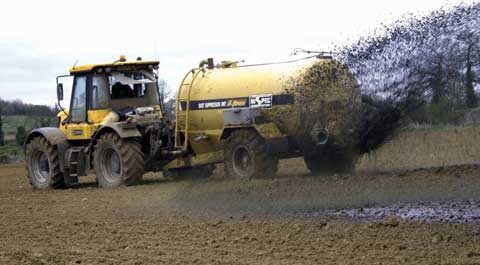
Along with the cough and murmur of cows and the muffled curses of the herdsman, the hoot of a vacuum tanker pump in full song is part of many dairy farms. Mostly these pumps – pto-powered and often Italian-made – chug on for years, if not decades, slowly shedding non-vital bits and disappearing under a crust of black oil and old slurry.
But there comes a time when the hooting stops. Or it becomes so ineffective that the tanker won’t fill. Then what are your options? Rebuild or replace, says Shropshire-based specialist Maurice Latham, who knows these units inside out (see Causes and costs for possibilities).
If you like DIY, here’s a refurbishment guide for the most common pump on UK tankers – Battioni and Pagani’s MEC unit.
This comes in various sizes, driven by pto (models MEC/M, MEC/D) or hydrostatically (MEC/H), with a model suffix declaring airflow in 1/min, for example 5000 or 8000. Operation is always the same.
A gear-driven, offset rotor spins inside a twin-ported chamber. Centrifugal force throws sliding vanes against the chamber wall, where they sweep air from one port to the other.
The pump connects to the spreader tank through a diverter valve. Set in one direction, this valve connects the pump’s inlet to the tank, sucking air from it. Set in the other direction it joins the pump’s exhaust port to the tank, pressurising the contents for emptying.
A ball valve in the inlet port prevents air suck-back into the tank when the pump stops. A relief valve limits the extent of pressure build-up, while an implosion valve can be added to allow limited air through the pump at maximum vacuum to cool it.
Forced lubrication comes from a small pump driven by the rotor, delivering oil through a (usually) adjustable drip feed.
One word of caution before you go. Begin the stripdown from the oil pump end of the unit, not at the gearbox. If you take the gearbox off, withdraw the rotor and leave the oil pump end cover in place, otherwise you won’t be able to line up the oil pump drive plate on re-assembly. This will lead to tears.
For a step-by-step guide to rebuilding a vacuum tanker pump, see here.
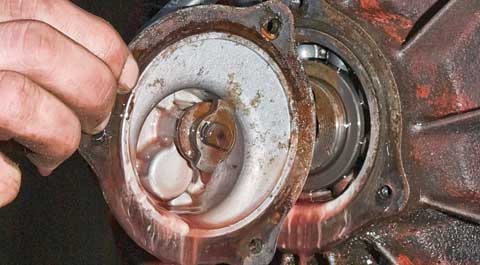
1 Start at the oil pump end. Take off the pump, then rescue its drive plate and spacer ring.
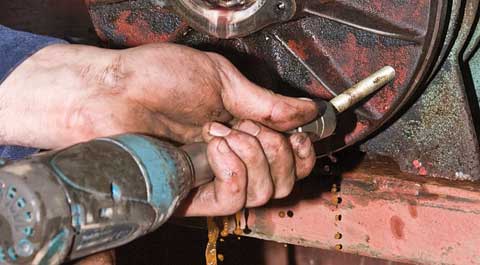
2 Take out the bolts holding the pump-end backplate. Find two M12 setscrews, start them in the backplate’s two threaded holes and tighten them evenly, a little at a time, to push the backplate off the rotor shaft. Some pumps also have a circlip here at the gearbox end.
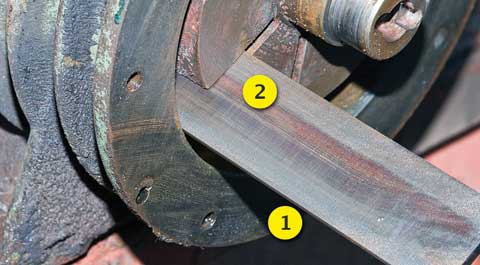
3 With the backplate off you’ll see the rotor and vanes. Vanes wear at their tips (1), in the area where they seat in the rotor slots (2) and where they slide against the chamber and plates. The greater the wear, the greater the chance of vane breakage. These aren’t too bad but will be changed anyway.
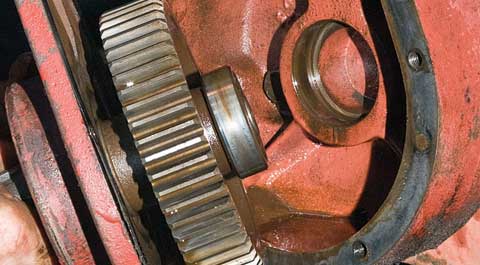
4 Switching to the other end of the pump, drain the gearbox oil and take off the end cover. Check the tears wear, overheating and perhaps broken teeth will turn up if the pump has been run low on oil.
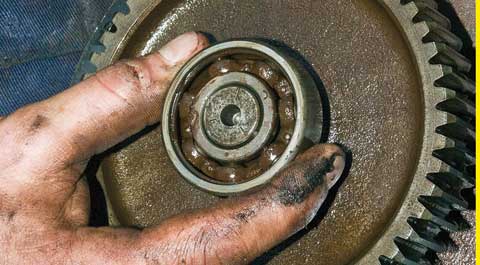
5 The input shaft’s rear support bearing often wears out; rock it to find play. This one was past its best and will be changed, along with all the other bearings. There’s little point in putting old items back once you have the pump apart, even if they seem OK – if the pump seizes, the bearings usually suffer.
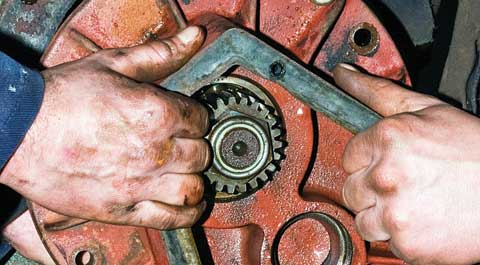
6 Unbolt the gearbox casing from the rotor housing, not forgetting the two inside fasteners. The rotor assembly is weighty, so it is best withdrawn by two people.
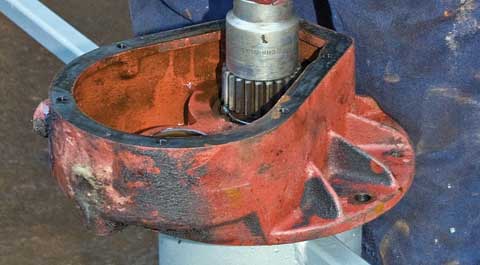
7 Take off the nut that holds the rotor drive gear to the shaft. The gear can’t readily be taken off, as there is no room behind it for a puller. Time for Maurice Latham’s special device…
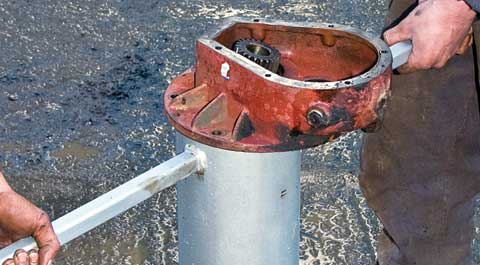
…which is 610mm (24in) of 160mm 1D tube, with the bottom end closed off, with handles welded to either side. With the rotor hanging inside the tube, suspended from the gearbox casing, a couple of sharp raps on the ground lets gravity do the work. Neat, eh?
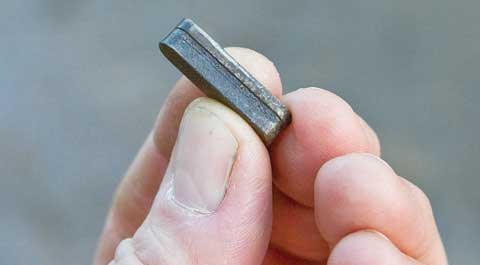
8 Find and inspect the key that located the gear on its shaft; this one is worn so must be changed. Retrieve the small spacer ring from below the bear.
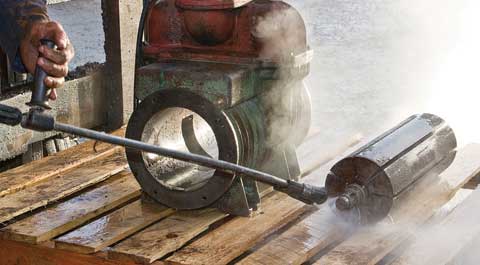
9 The pump core is now stripped. Pressure wash (ideally steam-clean) the rotor casing and rotor, blasting all dirt from the vane slots.
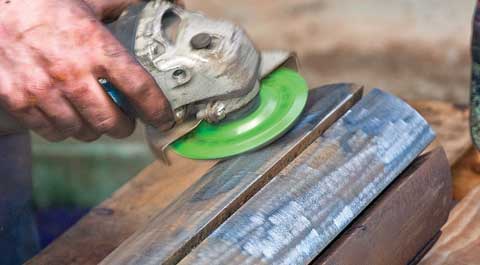
10 If a pump stands idle as this one had, the rotor and housing can rust. Rehabilitation starts with a gentle buffing from a flap wheel…
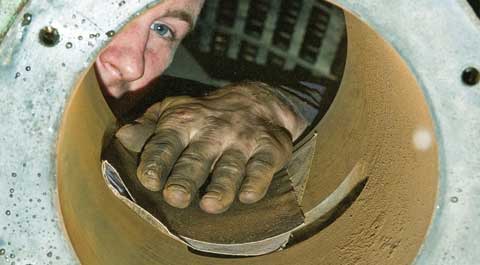
…backed up by an emery cloth.
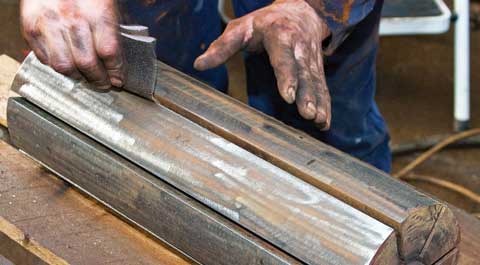
11 Again, concentrate cleaning on the vane slots. It’s essential that the vanes can slide freely.
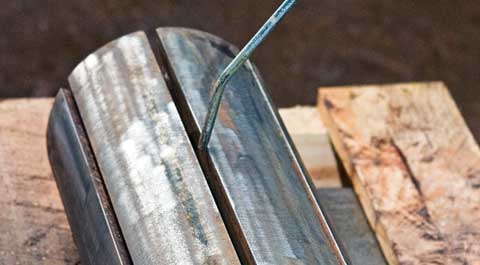
12 Blow the rotor and casing clear. Buff and clean the rotor chamber end plates in the same way.
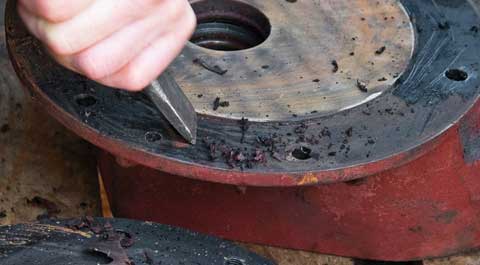
13 To finish stripdown, drive out or pull off the remaining bearings and tap out all old seals. Clean up joint faces with a blunt scraper, ready to take new gaskets.
A lack of suck may not be down to the pump. If it blows and spreads normally, suspect the pipework and tanker traps.
The liner of the hose that joins the pump to the tank can collapse under suction, with no visible sign. Disconnect it at the pump end; if the noise and volume of air from the pump exhaust jump up, suspect the hose.
Poor performance is usually down to wear. But if the tanker’s internal anti-overfill ball valve gives up, slurry can be drawn into the pump to seize or break rotor vanes. Check the tank ball valves if you find slurry on stripdown – especially the one at the top of the tanker.
Should you rebuild a worn pump or replace it? A new MEC8000 has a RRP of £1147 plus VAT. Service exchange units aren’t available.
A pump sent to Latham Engineering is stripped and assessed; a badly scored rotor housing, bent rotor or unrecoverable gearbox means it’s junk. If the pump is basically sound, a rebuild (including new parts) is possible. Costs vary depending on the model.
All spares are available from Latahm Engineering (www.battionipaganipompe.it). To help with ordering, diagrams with part numbers are at www.battionipaganipompe.it.
For a step-by-step guide to rebuilding a vacuum tanker pump, see here.

